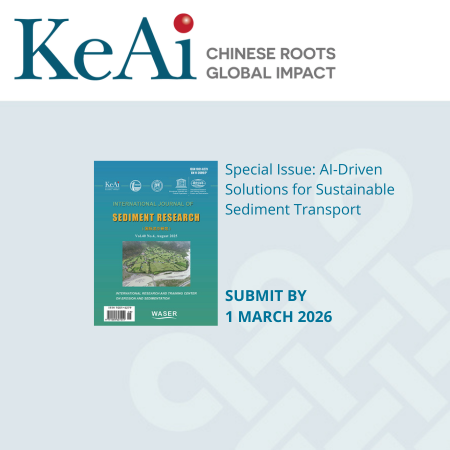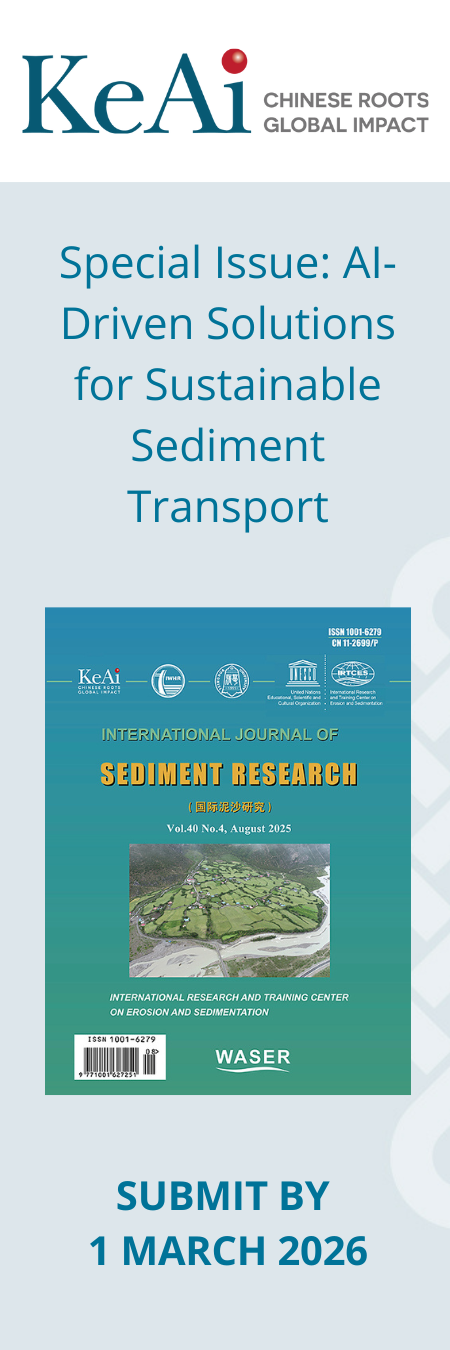Interpreting machine learning models based on SHAP values in predicting suspended sediment concentration
February 2025
Machine learning (ML) has become a powerful tool for predicting suspended sediment concentration (SSC). Nonetheless, the ability to interpret the physical process is considered the main issue in applying...
Review of methods of sediment detection in reservoirs
February 2024
As reservoir sedimentation is rapidly progressing on a global scale, intensified and better adapted monitoring of sediment accumulation is needed to design optimal counter measures. In the current study,...
A holistic view of aquatic ecosystems: Integrating health and integrity, network, stability, and regime shift assessments
February 2024
Aquatic ecosystems, especially freshwater ecosystems, are facing increasing anthropogenic disturbances, highlighting the urgency for accurate ecosystem assessment for informed decision-making and effective...
Assessment of soil erosion dynamics and implications for sustainable land management: A case study using the RUSLE model
June 2025
The current research aimed to evaluate the severity and distribution of soil erosion in a Swat district, Pakistan, which is vital for sustainable land management and conservation efforts. This study...
Particle size and settling velocity of bed and suspended sediments for mud-sand beds
April 2025
The particle size and the settling velocity of sediments are key parameters in sediment transport studies. However, it remains surprisingly difficult to determine particle size and settling velocity...
Quantitative definition of Shields criterion for incipient sediment motion
February 2024
The Shields diagram has been widely used in the description of the threshold condition for incipient sediment motion. Because the current definition of the Shields criterion is generally subjective,...
The use of InVEST-SDR model to evaluate soil erosion and sedimentation in the closer catchment of a proposed tropical reservoir in Sri Lanka
April 2025
Soil erosion is a significant environmental threat, impacting water quality and the siltation of the productive capacity of reservoirs. To prioritize soil conservation areas for sustainable land management,...
Sediment transport modeling for run-of-river hydropower in the Madeira River: Calibration with conventional and remote sensing data
October 2025
This study aims to evaluate sediment transport processes in the Madeira River, a high-load Amazon tributary altered by the Jirau run-of-river hydropower dam. A methodology for sensitivity analysis and...
Environmental radioactivity, radiological hazards, and trace elements assessment of nearshore sediment in the Bay of Bengal
February 2024
The current study focuses on the environmental radioactivity and multi-risk assessment of nearshore sediment as a source of marine pollution along the Bay of Bengal. The study examines the distribution...
Effect of reservoir management on the efficiency of a sediment bypass tunnel: Case study of Solis Reservoir, Switzerland
October 2025
Sediment bypass tunnels (SBTs) divert sediment-laden flows from river systems around reservoirs to the tailwater reach and thus help prevent reservoir sedimentation. However, their bypassing efficiency...
Prediction of suspended sediment concentration in fluvial flows using novel hybrid deep learning model
August 2025
Accurately predicting suspended sediment concentration (SSC) in fluvial systems is essential for environmental monitoring, flood management, and riverine engineering applications. This study introduces...
Effects of sample preparation methods on measured characteristics of marine and fluvial sediment
February 2024
Dredged sediment is complex material composed of mineral phases, organics phases, and liquid phases. For the characterization of sediment in the laboratory, the material should be dried before applying...
Near-wall flow characteristics in pipe bend dense slurries: Optimizing the maximum sliding frictional power
June 2024
In conveying concentrated liquid–solid mixtures in pipelines oriented horizontally, gravitational settling promotes a concentration-rich layer of solids at the pipe invert that degrades the wall due...
Grain size distribution and characterization of sedimentary processes of Cox's Bazar Beach, Bangladesh: Implications for understanding coastal morphodynamics
Available online 26 September 2025
This study aims to investigate the factors influencing modern beach development along the southeastern Bengal Basin coast by analyzing the grain size and heavy mineral (HM) distribution in sediment....
Sediment transport dynamics during a super flood: A case study of the 2010 super flood at the Guddu Barrage on the Indus River
October 2024
Annual sediment load transportation in the Indus River varies from 0.725 to 1.0 Mt/d and varies from 260 to 300 Mt/y. Sediment accumulation upstream of the inline structure (Guddu Barrage) has frequently...
Using Cs-137 measurements and RUSLE model to explore the effect of land use changes on soil erosion and deposition rates in a mid-sized catchment in southern Italy
April 2024
In some areas of southern Italy, the change in land use over the last 4–5 decades has increased pressure on land and water resources and caused different forms of soil degradation. In order to mitigate...
Review of soil solidification methods in scour and erosion control
December 2025
This review focuses on the mechanisms and scour resistance of various soil solidification methods used in civil and coastal engineering. Traditional chemical methods, such as ordinary Portland cement...
Transport of suspended sand and mud over a mud-sand bed
August 2025
This study is focused on the experimental and numerical modelling of sand and mud transport over mud-sand beds with percentages of fines (< 63 μm) up to 50% in conditions with currents, waves and combined...
Multidimensional assessment and precision restoration strategies for soil erosion in karst areas: Based on multi-scenario simulation
December 2025
Karst landscapes are plagued by severe soil erosion due to their fractured lithology and complex hydrology, posing persistent challenges to erosion assessment and ecological restoration. However, current...
Soil erosion susceptibility prediction using ensemble hybrid models with multicriteria decision-making analysis: Case study of the Medjerda basin, northern Africa
December 2024
Soil erosion is considered one of the most prevalent natural hazards in semiarid regions, leading to the instability of ecosystems and human life. The main purpose of this research was to investigate...
Experimental measurement of flocculation and settling behavior in fine sediments from the Three Gorges Reservoir, China
December 2025
Flocculation of cohesive sediments is widely observed in natural aquatic-sedimentary environments, such as river estuaries and nearshore coastal waters, where salinity, suspended sediment concentration...
Experimental study on the settling of irregularly shaped sediment particles from the source region of the Yangtze River
February 2025
Settling plays a pivotal role in sediment transport and morphological evolution of alluvial rivers. Sediment particles in the source regions of large rivers are more likely to feature irregular shapes...
Total arsenic contamination in soil, vegetables, and fruits and its potential health risks in the Chitral Valley, Pakistan
April 2024
Total arsenic (TAs) contamination is a serious health issue that affects many parts of the world. The sources of TAs in the Himalayas and Hindu Kush Mountains are rocks containing sulfide minerals and...
Effects of land management practices on runoff and soil and nutrient losses in the rainfed agroecosystem of the Beles River Basin, Ethiopia
August 2025
The Beles River Basin is facing severe soil erosion driven by human-induced activities, leading to significant losses of soil organic carbon (SOC) and nutrients (nitrogen (N) and phosphorus (P)). Effective...
Source distribution, ecological risks, and controlling factors of heavy metals in river sediments: Receptor model-based study in a transboundary river basin
February 2025
In the context of transboundary rivers, which constitute intricate fluvial ecosystems, the persistent threat of heavy metals (HMs) contamination poses significant risks to ecosystem health. In this...


